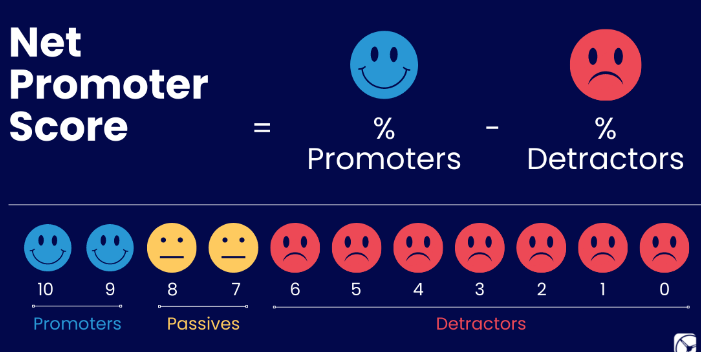Enhancing Customer Loyalty: The Role of Net Promoter Score in Business Strategy

Understanding the Net Promoter Score (NPS)
The Net Promoter Score (NPS) underscores the importance of customer loyalty in business success. Introduced by Fred Reichheld in 2003, NPS measures customer sentiment through a simple query, categorizing respondents as Detractors, Passives, or Promoters. NPS is a reliable growth predictor, calculated by subtracting Detractors from Promoters, driving proactive customer service and business development. Regular NPS assessment reflects a commitment to enhancing products/services based on customer feedback, fostering loyal clientele, and organic business expansion.
Why NPS Matters for Your Business
NPS extends beyond being a mere reflective practice; it is an indispensable tool for strategic business decisions. By closely monitoring Net Promoter Score (NPS), companies gauge overall customer perception and their position within the marketplace. This knowledge is imperative since customers actively promoting a brand will likely foster increased revenues through return business and referral traffic. It is telling that industry leaders often sport some of the highest NPS scores within their domains, signifying the strength of their customer relationships and product resonance.
Using NPS as a barometer against analogous businesses provides actionable insights and unveils opportunities for improvement. Comparison to industry norms can help distinguish whether a company is lagging, on par, or leading in customer satisfaction, aiding in formulating strategies to capture market share and customer mindshare.
The narrative of companies that have leveraged their NPS to effectuate pivotal changes and witnessed escalations in customer retention and profitability is standard. These companies often turn Promoters into brand assets, enabling them to reduce marketing costs due to their customers’ organic advocacy and the accompanying boost to the organization’s reputation.
Gathering Customer Feedback Effectively
Effectual feedback solicitation necessitates methodical and thoughtful execution. Empathic communication and well-timed surveys can yield a treasure trove of insights. One approach involves deploying NPS surveys immediately following a sales transaction or a significant interaction with customer service, thus capturing the customer’s experience while it’s still top-of-mind. Moreover, the rise of integrated customer relationship management (CRM) and survey software yields automation efficiencies, enabling regular feedback collection at scale without sacrificing the personal touch that encourages responses.
Strategic incentives are frequently employed to boost participation in NPS surveys. These need not be grandiose; even modest tokens of appreciation or future purchase discounts can have a palpable effect. By illustrating to customers that their opinions are valued and have tangible outcomes, firms can amplify their feedback intake, providing them with the customer insights necessary to make informed and impactful changes.
Acquiring a high volume of responses enhances the NPS data’s robustness, which improves the analysis and solidity of the derived insights. Organizations with high survey response rates often possess a wealth of actionable feedback, enabling them to be dynamic and customer-centric in their business modifications.
Interpreting Your NPS Results
Interpreting NPS results extends into qualitative analysis—digging into the reasons behind the scores, which involves parsing through customer comments, pinpointing prevalent pain points, and celebrating areas of success. Monitoring NPS trends over time, such as during product launches or policy changes, can showcase direct customer sentiment reactions to company actions. Understanding these fluctuations is vital to tapping into the underlying drivers of customer satisfaction and loyalty.
Encountering a troubling NPS score often sets the stage for rigorous introspection and catalyzes necessary change. When a company faces customer dissatisfaction, as reflected in its NPS, it is imperative to disaggregate the data, discern patterns, and initiate a dialogue with customers to elucidate specific grievances. By addressing concerns sincerely and transparently, a business can convert critics into advocates, ensuring that even a poor NPS score becomes a stepping-stone toward improvement.
A high NPS score, while affirming a job well done, isn’t an excuse for complacency but rather a signal to build on the positive momentum. Companies that maintain and grow their NPS do so by continuously enhancing the customer experience, ensuring they remain ahead in understanding and catering to customer needs.
From Numbers to Action: Leveraging NPS Insights
Using numeric data strategically drives company progress. NPS serves not just as a report card but also as a roadmap for future actions. “Promoters” signal advocacy opportunities, “Detractors” prompt service recovery, and “Passives” require loyalty-building efforts. Responsive service recovery can alter negative perceptions, while case studies provide narrative strength, guiding tailored solutions for improvement.
Cultivating Long-Term Customer Relationships With NPS
Forging lasting relationships with customers is the essence of longevity in business. Transparency about NPS findings and subsequent actions fosters a collaborative environment where customers feel heard and see their feedback effect change. This dynamic is especially pertinent when managing those categorized as Detractors; addressing their concerns directly and demonstrating a genuine commitment to service improvement can convert dissatisfaction into loyalty.
On the opposite end of the spectrum, Promoters represent a segment enthusiastic about their brand interaction, embodying the potential for organic growth. Customers will participate in referral programs or provide testimonials, offering authentic voices that resonate with prospects. Techniques to engage and mobilize this group include:
- Exclusive benefits.
- Early access to new releases.
- Simply regular recognition of their support.
Passives sit squarely in the middle, satisfied but not enthusiastically so. They may require additional motivation—via loyalty incentives, enhanced customer service, or personalized product offerings—to tilt their experience from satisfactory to exceptional. Businesses can nurture a more vibrant and engaged customer base by curating targeted strategies for each customer segment.
The Future of NPS: Trends and Predictions
As we enter the digital age, NPS methodologies and applications are evolving. With each technological leap—from mobile platforms to sophisticated analytics tools—the mechanisms for capturing and responding to customer feedback become more refined and seamless. Companies employ diverse channels, including social media and mobile apps, to effectively engage customers and solicit their NPS feedback.
Integrating NPS data with advanced analytics, particularly predictive analytics, opens up new vistas for preempting customer needs and fine-tuning service delivery. By correlating NPS data with customer behavior patterns, businesses can gain forward-looking insights, enabling them to foresee and forestall potential churn scenarios or identify opportunities for promoting higher levels of customer advocacy.
The emerging methods for customer feedback collection discussed indicate a trajectory towards more intuitive and engaging feedback mechanisms facilitated by technology. These innovative approaches are set to redefine the landscape of customer feedback and measurement.
NPS and Employee Engagement: A Dual Approach
A vital aspect of a successful NPS program is the symbiosis between customer feedback and employee engagement. Companies with a workforce deeply attuned to customer sentiment often exhibit higher NPS scores, underlining the direct correlation between how valued employees feel and how they manage customer relationships. Galvanized employees tend to deliver superior customer service, resulting in a mutually beneficial feedback loop of satisfied customers and dedicated staff.
Encouraging internal feedback loops mirroring the NPS framework can yield significant dividends. By soliciting and addressing employee feedback with the same regard as customer feedback, businesses create an environment that values continuous improvement and honors worker input, further strengthening the ties between employee satisfaction, customer happiness, and overall business health.
There are noted instances where companies with robust cultures of soliciting and acting on customer and employee feedback rank highly on NPS and workplace satisfaction surveys—a testament to the dual impact of fostering internal and external relationships rooted in trust and responsiveness.
Read also Navigating the Digital Transformation of Recruitment
Integrating NPS Into Corporate Governance
Forward-thinking organizations recognize NPS as a strategic asset that supplements financial metrics and operational data. By elevating NPS to a boardroom discussion point, businesses affirm their dedication to customer-centricity, which can profoundly influence organizational planning, shaping agendas, and prioritizing the customer experience.
In alignment with corporate governance, NPS data and interpretations can play a pivotal role in the reporting and strategic communication with shareholders and stakeholders, underpinning the narrative of a business firmly oriented around its customers’ needs and experiences.
Furthermore, incorporating NPS into corporate governance signifies a transformation in business ethos. As the metric gains prominence, many companies recognize its importance in shaping a culture that responds to, anticipates, and sets new customer satisfaction standards.
Enhancing the NPS Experience With Technology
The digital revolution has thrust AI to the forefront of modern business practice, with significant implications for how NPS data is collected and utilized. AI and machine learning techniques enable not just the aggregation of large quantities of data but also the extraction of nuanced patterns and sentiments, providing businesses with advanced insight into customer experiences that were previously inaccessible.
As businesses harness these advanced analytics capabilities, the scope for personalized customer engagement scales exponentially, presenting new opportunities to tailor experiences and accomplish unprecedented levels of service customization.
An online article details an illuminating example of these innovations in discussing how AI can transform customer feedback and NPS. Forbes’ insights underline the potential to revolutionize customer relationship management by harnessing next-generation AI tools to significantly refine the Net Promoter Score experience.





